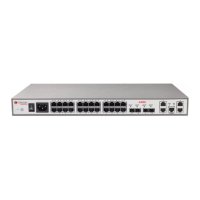A10E/A28E/A28F Configuration Guide
4.1.5 Priority mapping
When packets enter the A10E/A28E, priority mapping function sends them to queues with
different internal priority in accordance with mapping relationship from external to internal,
thus the packets can perform queue schedule at packets egress direction.
The device supports priority mapping over DSCP priority or CoS priority.
By default, the mapping relationship between device local priority and DSCP priority, local
priority and CoS priority is shown below:
Table 4-1 Mapping relationship of local priority, DSCP priority, and CoS priority
Local priority refers to a kind of packet priority with internal meaning assigned by the
A10E/A28E, i.e. the priority corresponding to queue in QoS queue schedule.
Local priority range is 0–7; each interface of the A10E/A28E supports eight queues; local
priority and interface queue is one-to-one corresponding relationship; the packet can be sent
to assigned queue according to the mapping relationship between local priority and queue, as
shown below.
Table 4-2 Mapping between local priority and queue
4.1.6 Congestion management
Queue schedule is necessary when there is intermittent congestion in network or delay
sensitive services require higher QoS service than non-sensitive services.
Queue schedule adopts different schedule algorithm to transport packets flow in queue. The
device supports Strict Priority (SP), Weight Round Robin (WRR), and SP+WRR algorithm to
solve network flow problem and have different influences on distribution, delay, and jitter of
bandwidth resource.
SP: to schedule strictly according to queue priority order. Lower priority queue cannot
perform schedule until the packets in higher priority queue all finished schedule, as
shown below.

